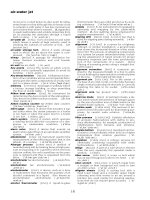Fundamentals of WiMAX (P2)
Bạn đang xem bản rút gọn của tài liệu. Xem và tải ngay bản đầy đủ của tài liệu tại đây (173.02 KB, 20 trang )
This page intentionally left blank
3
C
HAPTER
1
Introduction to Broadband
Wireless
B
roadband wireless sits at the confluence of two of the most remarkable growth stories of the
telecommunications industry in recent years. Both wireless and broadband have on their
own enjoyed rapid mass-market adoption. Wireless mobile services grew from 11 million sub-
scribers worldwide in 1990 to more than 2 billion in 2005 [1]. During the same period, the Inter-
net grew from being a curious academic tool to having about a billion users. This staggering
growth of the Internet is driving demand for higher-speed Internet-access services, leading to a
parallel growth in broadband adoption. In less than a decade, broadband subscription worldwide
has grown from virtually zero to over 200 million [2]. Will combining the convenience of wire-
less with the rich performance of broadband be the next frontier for growth in the industry? Can
such a combination be technically and commercially viable? Can wireless deliver broadband
applications and services that are of interest to the endusers? Many industry observers believe so.
Before we delve into broadband wireless, let us review the state of broadband access today.
Digital subscriber line (DSL) technology, which delivers broadband over twisted-pair telephone
wires, and cable modem technology, which delivers over coaxial cable TV plant, are the predom-
inant mass-market broadband access technologies today. Both of these technologies typically
provide up to a few megabits per second of data to each user, and continuing advances are mak-
ing several tens of megabits per second possible. Since their initial deployment in the late 1990s,
these services have enjoyed considerable growth. The United States has more than 50 million
broadband subscribers, including more than half of home Internet users. Worldwide, this num-
ber is more than 200 million today and is projected to grow to more than 400 million by 2010
[2]. The availability of a wireless solution for broadband could potentially accelerate this
growth.
What are the applications that drive this growth? Broadband users worldwide are finding that
it dramatically changes how we share information, conduct business, and seek entertainment.
4 Chapter 1 • Introduction to Broadband Wireless
Broadband access not only provides faster Web surfing and quicker file downloads but also
enables several multimedia applications, such as real-time audio and video streaming, multimedia
conferencing, and interactive gaming. Broadband connections are also being used for voice tele-
phony using voice-over-Internet Protocol (VoIP) technology. More advanced broadband access
systems, such as fiber-to-the-home (FTTH) and very high data rate digital subscriber loop
(VDSL), enable such applications as entertainment-quality video, including high-definition TV
(HDTV) and video on demand (VoD). As the broadband market continues to grow, several new
applications are likely to emerge, and it is difficult to predict which ones will succeed in the
future.
So what is broadband wireless? Broadband wireless is about bringing the broadband experi-
ence to a wireless context, which offers users certain unique benefits and convenience. There are
two fundamentally different types of broadband wireless services. The first type attempts to pro-
vide a set of services similar to that of the traditional fixed-line broadband but using wireless as
the medium of transmission. This type, called fixed wireless broadband, can be thought of as a
competitive alternative to DSL or cable modem. The second type of broadband wireless, called
mobile broadband, offers the additional functionality of portability, nomadicity,
1
and mobility.
Mobile broadband attempts to bring broadband applications to new user experience scenarios
and hence can offer the end user a very different value proposition. WiMAX (worldwide interop-
erability for microwave access) technology, the subject of this book, is designed to accommo-
date both fixed and mobile broadband applications.
Figure 1.1 Worldwide subscriber growth 1990–2006 for mobile telephony, Internet usage, and
broadband access [1, 2, 3]
1. Nomadicity implies the ability to connect to the network from different locations via different base
stations; mobility implies the ability to keep ongoing connections active while moving at vehicular
speeds.
0
500
1,000
1,500
2,000
2,500
’90 ’92 ’94 ’96 ’98 ’00 ’02 ’04 ’06
Mobile Subscribers
(millions)
0
200
400
600
800
1,000
1,200
1,400
1,600
Internet/Broadband Subscribers
(millions)
Mobile
Internet
Broadband
1.1 Evolution of Broadband Wireless 5
In this chapter, we provide a brief overview of broadband wireless. The objective is to
present the the background and context necessary for understanding WiMAX. We review the
history of broadband wireless, enumerate its applications, and discuss the business drivers and
challenges. In Section 1.7, we also survey the technical challenges that need to be addressed
while developing and deploying broadband wireless systems.
1.1 Evolution of Broadband Wireless
The history of broadband wireless as it relates to WiMAX can be traced back to the desire to
find a competitive alternative to traditional wireline-access technologies. Spurred by the deregu-
lation of the telecom industry and the rapid growth of the Internet, several competitive carriers
were motivated to find a wireless solution to bypass incumbent service providers. During the
past decade or so, a number of wireless access systems have been developed, mostly by start-up
companies motivated by the disruptive potential of wireless. These systems varied widely in
their performance capabilities, protocols, frequency spectrum used, applications supported, and
a host of other parameters. Some systems were commercially deployed only to be decommis-
sioned later. Successful deployments have so far been limited to a few niche applications and
markets. Clearly, broadband wireless has until now had a checkered record, in part because of
the fragmentation of the industry due to the lack of a common standard. The emergence of
WiMAX as an industry standard is expected to change this situation.
Given the wide variety of solutions developed and deployed for broadband wireless in the
past, a full historical survey of these is beyond the scope of this section. Instead, we provide a
brief review of some of the broader patterns in this development. A chronological listing of some
of the notable events related to broadband wireless development is given in Table 1.1.
WiMAX technology has evolved through four stages, albeit not fully distinct or clearly
sequential: (1) narrowband wireless local-loop systems, (2) first-generation line-of-sight (LOS)
broadband systems, (3) second-generation non-line-of-sight (NLOS) broadband systems, and
(4) standards-based broadband wireless systems.
1.1.1 Narrowband Wireless Local-Loop Systems
Naturally, the first application for which a wireless alternative was developed and deployed was
voice telephony. These systems, called wireless local-loop (WLL), were quite successful in
developing countries such as China, India, Indonesia, Brazil, and Russia, whose high demand
for basic telephone services could not be served using existing infrastructure. In fact, WLL sys-
tems based on the digital-enhanced cordless telephony (DECT) and code division multiple
access (CDMA) standards continue to be deployed in these markets.
In markets in which a robust local-loop infrastructure already existed for voice telephony,
WLL systems had to offer additional value to be competitive. Following the commercialization
of the Internet in 1993, the demand for Internet-access services began to surge, and many saw
providing high-speed Internet-access as a way for wireless systems to differentiate themselves.
For example, in February 1997, AT&T announced that it had developed a wireless access system
6 Chapter 1 • Introduction to Broadband Wireless
for the 1,900MHz PCS (personal communications services) band that could deliver two voice
lines and a 128kbps data connection to subscribers. This system, developed under the code name
“Project Angel,” also had the distinction of being one of the first commercial wireless systems to
use adaptive antenna technology. After field trials for a few years and a brief commercial offer-
ing, AT&T discontinued the service in December 2001, citing cost run-ups and poor take-rate as
reasons.
During the same time, several small start-up companies focused solely on providing Inter-
net-access services using wireless. These wireless Internet service provider (WISP) companies
typically deployed systems in the license-exempt 900MHz and 2.4GHz bands. Most of these
systems required antennas to be installed at the customer premises, either on rooftops or under
the eaves of their buildings. Deployments were limited mostly to select neighborhoods and small
towns. These early systems typically offered speeds up to a few hundred kilobits per second.
Later evolutions of license-exempt systems were able to provide higher speeds.
1.1.2 First-Generation Broadband Systems
As DSL and cable modems began to be deployed, wireless systems had to evolve to support
much higher speeds to be competitive. Systems began to be developed for higher frequencies,
such as the 2.5GHz and 3.5GHz bands. Very high speed systems, called local multipoint distri-
bution systems (LMDS), supporting up to several hundreds of megabits per second, were also
developed in millimeter wave frequency bands, such as the 24GHz and 39GHz bands. LMDS-
based services were targeted at business users and in the late 1990s enjoyed rapid but short-lived
success. Problems obtaining access to rooftops for installing antennas, coupled with its shorter-
range capabilities, squashed its growth.
In the late 1990s, one of the more important deployments of wireless broadband happened
in the so-called multichannel multipoint distribution services (MMDS) band at 2.5GHz. The
MMDS band was historically used to provide wireless cable broadcast video services, especially
in rural areas where cable TV services were not available. The advent of satellite TV ruined the
wireless cable business, and operators were looking for alternative ways to use this spectrum. A
few operators began to offer one-way wireless Internet-access service, using telephone line as
the return path. In September 1998, the Federal Communications Commission (FCC) relaxed
the rules of the MMDS band in the United States to allow two-way communication services,
sparking greater industry interest in the MMDS band. MCI WorldCom and Sprint each paid
approximately $1 billion to purchase licenses to use the MMDS spectrum, and several compa-
nies started developing high-speed fixed wireless solutions for this band.
The first generation of these fixed broadband wireless solutions were deployed using the
same towers that served wireless cable subscribers. These towers were typically several hundred
feet tall and enabled LOS coverage to distances up to 35 miles, using high-power transmitters.
First-generation MMDS systems required that subscribers install at their premises outdoor
antennas high enough and pointed toward the tower for a clear LOS transmission path. Sprint
and MCI launched two-way wireless broadband services using first-generation MMDS systems
1.1 Evolution of Broadband Wireless 7
in a few markets in early 2000. The outdoor antenna and LOS requirements proved to be signifi-
cant impediments. Besides, since a fairly large area was being served by a single tower, the
capacity of these systems was fairly limited. Similar first-generation LOS systems were
deployed internationally in the 3.5GHz band.
Table 1.1 Important Dates in the Development of Broadband Wireless
Date Event
February 1997
AT&T announces development of fixed wireless technology code named “Project
Angel”
February 1997
FCC auctions 30MHz spectrum in 2.3GHz band for wireless communications services
(WCS)
September 1997
American Telecasting (acquired later by Sprint) announces wireless Internet access
services in the MMDS band offering 750kbps downstream with telephone dial-up
modem upstream
September 1998 FCC relaxes rules for MMDS band to allow two-way communications
April 1999
MCI and Sprint acquire several wireless cable operators to get access to MMDS
spectrum
July 1999 First working group meeting of IEEE 802.16 group
March 2000 AT&T launches first commercial high-speed fixed wireless service after years of trial
May 2000
Sprint launches first MMDS deployment in Phoenix, Arizona, using first-generation
LOS technology
June 2001 WiMAX Forum established
October 2001 Sprint halts MMDS deployments
December 2001 AT&T discontinues fixed wireless services
December 2001 IEEE 802.16 standards completed for > 11GHz.
February 2002 Korea allocates spectrum in the 2.3GHz band for wireless broadband (WiBro)
January 2003 IEEE 802.16a standard completed
June 2004 IEEE 802.16-2004 standard completed and approved
September 2004 Intel begins shipping the first WiMAX chipset, called Rosedale
December 2005 IEEE 802.16e standard completed and approved
January 2006 First WiMAX Forum–certified product announced for fixed applications
June 2006 WiBro commercial services launched in Korea
August 2006 Sprint Nextel announces plans to deploy mobile WiMAX in the United States
8 Chapter 1 • Introduction to Broadband Wireless
1.1.3 Second-Generation Broadband Systems
Second-generation broadband wireless systems were able to overcome the LOS issue and to pro-
vide more capacity. This was done through the use of a cellular architecture and implementation
of advanced-signal processing techniques to improve the link and system performance under
multipath conditions. Several start-up companies developed advanced proprietary solutions that
provided significant performance gains over first-generation systems. Most of these new sys-
tems could perform well under non-line-of-sight conditions, with customer-premise antennas
typically mounted under the eaves or lower. Many solved the NLOS problem by using such tech-
niques as orthogonal frequency division multiplexing (OFDM), code division multiple access
(CDMA), and multiantenna processing. Some systems, such as those developed by SOMA Net-
works and Navini Networks, demonstrated satisfactory link performance over a few miles to
desktop subscriber terminals without the need for an antenna mounted outside. A few megabits
per second throughput over cell ranges of a few miles had become possible with second-
generation fixed wireless broadband systems.
1.1.4 Emergence of Standards-Based Technology
In 1998, the Institute of Electrical and Electronics Engineers (IEEE) formed a group called
802.16 to develop a standard for what was called a wireless metropolitan area network, or wire-
less MAN. Originally, this group focused on developing solutions in the 10GHz to 66GHz band,
with the primary application being delivering high-speed connections to businesses that could
not obtain fiber. These systems, like LMDS, were conceived as being able to tap into fiber rings
and to distribute that bandwidth through a point-to-multipoint configuration to LOS businesses.
The IEEE 802.16 group produced a standard that was approved in December 2001. This stan-
dard, Wireless MAN-SC, specified a physical layer that used single-carrier modulation tech-
niques and a media access control (MAC) layer with a burst time division multiplexing (TDM)
structure that supported both frequency division duplexing (FDD) and time division duplexing
(TDD).
After completing this standard, the group started work on extending and modifying it to
work in both licensed and license-exempt frequencies in the 2GHz to 11GHz range, which
would enable NLOS deployments. This amendment, IEEE 802.16a, was completed in 2003,
with OFDM schemes added as part of the physical layer for supporting deployment in multipath
environments. By this time, OFDM had established itself as a method of choice for dealing with
multipath for broadband and was already part of the revised IEEE 802.11 standards. Besides the
OFDM physical layers, 802.16a also specified additional MAC-layer options, including support
for orthogonal frequency division multiple access (OFDMA).
Further revisions to 802.16a were made and completed in 2004. This revised standard, IEEE
802.16-2004, replaces 802.16, 802.16a, and 802.16c with a single standard, which has also been
adopted as the basis for HIPERMAN (high-performance metropolitan area network) by ETSI
(European Telecommunications Standards Institute). In 2003, the 802.16 group began work on
enhancements to the specifications to allow vehicular mobility applications. That revision,
1.1 Evolution of Broadband Wireless 9
802.16e, was completed in December 2005 and was published formally as IEEE 802.16e-2005.
It specifies scalable OFDM for the physical layer and makes further modifications to the MAC
layer to accommodate high-speed mobility.
As it turns out, the IEEE 802.16 specifications are a collection of standards with a very
broad scope. In order to accommodate the diverse needs of the industry, the standard incorpo-
rated a wide variety of options. In order to develop interoperable solutions using the 802.16 fam-
ily of standards, the scope of the standard had to be reduced by establishing consensus on what
options of the standard to implement and test for interoperability. The IEEE developed the spec-
ifications but left to the industry the task of converting them into an interoperable standard that
can be certified. The WiMAX Forum was formed to solve this problem and to promote solutions
based on the IEEE 802.16 standards. The WiMAX Forum was modeled along the lines of the
Wi-Fi Alliance, which has had remarkable success in promoting and providing interoperability
testing for products based on the IEEE 802.11 family of standards.
The WiMAX Forum enjoys broad participation from the entire cross-section of the industry,
including semiconductor companies, equipment manufacturers, system integraters, and service
Sidebar 1.1 A Brief History of OFDM
Although OFDM has become widely used only recently, the concept dates
back some 40 years. This brief history of OFDM cites some landmark dates.
1966: Chang shows that multicarrier modulation can solve the multipath
problem without reducing data rate [4]. This is generally considered
the first official publication on multicarrier modulation. Some earlier
work was Holsinger’s 1964 MIT dissertation [5] and some of Gal-
lager’s early work on waterfilling [6].
1971: Weinstein and Ebert show that multicarrier modulation can be
accomplished using a DFT [7].
1985: Cimini at Bell Labs identifies many of the key issues in OFDM
transmission and does a proof-of-concept design [8].
1993: DSL adopts OFDM, also called discrete multitone, following
successful field trials/competitions at Bellcore versus equalizer-based
systems.
1999: The IEEE 802.11 committee on wireless LANs releases the 802.11a
standard for OFDM operation in 5GHz UNI band.
2002: The IEEE 802.16 committee releases an OFDM-based standard for
wireless broadband access for metropolitan area networks under revi-
sion 802.16a.
2003: The IEEE 802.11 committee releases the 802.11g standard for opera-
tion in the 2.4GHz band.
2003: The multiband OFDM standard for ultrawideband is developed, show-
ing OFDM’s usefulness in low-SNR systems.









